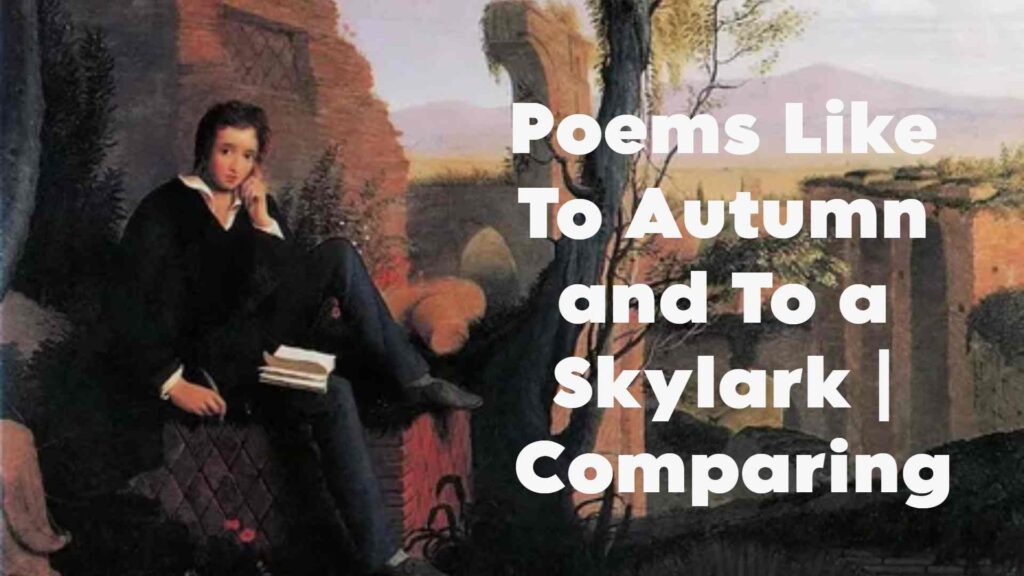Poetry, with its evocative language and emotional depth, has the power to transcend time and touch the soul. Among the pantheon of great poets, John Keats and Percy Bysshe Shelley stand out for their vivid imagery and profound themes. Their Poems Like To Autumn And To A Skylark respectively are celebrated masterpieces, often studied and admired for their beauty and intricacy. In this article, we will delve into the world of these poems, examining their themes, styles, and the reasons behind their enduring appeal.
Poems Poems Like To Autumn And To A Skylark
The Beauty of “To Autumn”
Keats’ Ode to the Season of Change
John Keats’ “To Autumn” is an ode that celebrates the season of autumn, depicting it as a time of abundance, maturity, and impending decline. The poem is rich in sensory details, bringing to life the sights, sounds, and smells of the season. Keats personifies autumn, presenting it as a close friend of the sun, collaborating to bring about the ripeness and fullness of the harvest.
Themes and Imagery in “To Autumn”
The central themes of “To Autumn” include the natural cycle of growth and decay, the passage of time, and the beauty found in every stage of life. Keats’ imagery is lush and detailed, from the “mists and mellow fruitfulness” to the “barred clouds bloom the soft-dying day.” This vivid portrayal of autumn invites readers to appreciate the transient beauty of nature.
Stylistic Elements in “To Autumn”
Keats employs a variety of stylistic elements in “To Autumn,” including a consistent rhyme scheme and the use of iambic pentameter. The poem is structured in three stanzas, each focusing on different aspects of autumn—its bounty, its labor, and its twilight. This structure reflects the progression of the season and enhances the poem’s meditative tone.
The Majesty of “To a Skylark”
Shelley’s Ode to the Unseen Bird
Percy Bysshe Shelley’s “To a Skylark” is a hymn of praise to the skylark, a bird that symbolizes pure, unbridled joy. Unlike Keats’ “To Autumn,” which is grounded in sensory reality, Shelley’s poem explores the ethereal and the abstract. The skylark, rarely seen but often heard, becomes a metaphor for poetic inspiration and transcendent beauty.
Themes and Imagery in “To a Skylark”
The themes of “To a Skylark” revolve around the contrast between earthly suffering and heavenly joy, the limitations of human experience, and the boundless freedom of the skylark. Shelley’s imagery is both vivid and imaginative, describing the skylark as a “blithe Spirit” and comparing it to a “cloud of fire” and “a star of Heaven.”
Stylistic Elements in “To a Skylark”
Shelley’s stylistic approach in “To a Skylark” includes the use of lyrical language, complex metaphors, and a flexible rhyme scheme. The poem is composed of twenty-one stanzas, each contributing to the build-up of the skylark’s divine attributes. This structure allows Shelley to explore the skylark’s symbolic significance from multiple angles.
To the Evening
Softly comes the evening, draped in twilight’s hue, A whisper on the breeze, the sky a pastel blue, The sun dips low, its rays a golden thread, Weaving shadows long, as daylight gently sheds.
The fields in quiet repose, the day’s work done, Whispers of the harvest linger, kissed by the sun, Beneath the oak, the crickets sing their tune, A serenade to stars, soon to be strewn.
In twilight’s tender arms, the world finds peace, The labors of the day, in quiet, cease, The scent of earth, of leaves, of gathered sheaves, In evening’s gentle clasp, the spirit breathes.
O evening, gentle muse, of calm and grace, Your tender light, a balm, a soft embrace, In your quiet hour, the heart finds rest, Beneath your tranquil skies, the soul is blessed.
Also Read: CallEscort Review & Top-12 Escort Sites Like CallEscort.org
To a Nightingale
O nightingale, sweet harbinger of night, Your song, a silver thread in the twilight, Above the meadows, soft and lush with dew, Your melody ascends, the heavens imbue.
You rise on wings, through twilight’s tender veil, With notes so pure, they weave a magic tale, Of distant lands, where dreams and fancies lie, Beneath the canopy of the starlit sky.
Your song, a timeless echo in the dark, Ignites the soul, as if a heavenly spark, In shadows deep, where mysteries unfold, Your voice, a story ancient and yet untold.
O nightingale, your song, a gift divine, Resonates within, a sacred, gentle sign, That in the silent night, when all is still, The heart can soar, can dream, can softly thrill.
The Timeless Appeal of Nature Poetry
Nature as Inspiration
Both “To Autumn” and “To a Skylark” exemplify the Romantic era’s fascination with nature as a source of inspiration and reflection. For Keats and Shelley, nature is not just a backdrop but a dynamic, living force that mirrors human emotions and experiences. This connection to nature is a key reason why these poems continue to resonate with readers today.
The Emotional Resonance of Poetry
Poems like “To Autumn” and “To a Skylark” touch upon universal themes such as beauty, joy, and the passage of time. Their emotional resonance lies in their ability to evoke a deep, often visceral response in readers. By capturing fleeting moments and transcendent experiences, these poems offer a timeless reflection on the human condition.
Comparing “To Autumn” and “To a Skylark”
Different Yet Complementary
While “To Autumn” and “To a Skylark” differ in their subject matter and tone. They complement each other in their exploration of nature and beauty. Keats’ poem is more grounded and sensory, focusing on the tangible aspects of autumn. In contrast, Shelley’s poem is more abstract and ethereal, celebrating the intangible qualities of the skylark’s song.
Exploring the Human Experience
Both poems also delve into the human experience, albeit from different perspectives. “To Autumn” reflects on the natural cycle of life, with its inevitable decline and renewal. “To a Skylark,” on the other hand, contrasts human limitations with the skylark’s boundless joy, highlighting the aspirational nature of human creativity.
The Influence of Romanticism
Romantic Ideals in Poetry
The Romantic movement, characterized by an emphasis on emotion, nature, and individualism, heavily influences both “To Autumn” and “To a Skylark.” Keats and Shelley, as leading figures of this movement, imbue their poems with Romantic ideals. Their focus on nature as a source of inspiration and their celebration of the sublime and the beautiful are hallmarks of Romantic poetry.
Legacy of Keats and Shelley
Keats and Shelley left an indelible mark on the literary world, with their works continuing to be studied and admired. Their ability to capture the essence of their subjects and evoke deep emotional responses has ensured their place in the canon of great English poets. The themes and stylistic elements of their poems remain relevant, offering insights into the human condition and the natural world.
The Craft of Writing Nature Poetry
Balancing Detail and Emotion
Writing nature poetry, as exemplified by Keats and Shelley, involves a delicate balance of detail and emotion. Vivid descriptions of the natural world, combined with introspective and emotional reflections, create a rich tapestry that engages readers. Aspiring poets can learn from Keats’ attention to sensory detail and Shelley’s imaginative metaphors.
Embracing the Transient
Nature poetry often celebrates the transient, capturing moments of beauty that are fleeting yet profound. This theme is evident in both “To Autumn” and “To a Skylark,” where the poets revel in the ephemeral nature of their subjects. Embracing this transient quality can add depth and resonance to poetry, highlighting the impermanence of life and beauty.
The Enduring Power of Poetry
Connecting Across Time
Poems like “To Autumn” and “To a Skylark” demonstrate the enduring power of poetry to connect with readers across time. Despite being written over a century ago, these poems continue to speak to modern audiences, offering insights into the natural world and the human experience. Their timeless appeal lies in their universal themes and masterful execution.
Inspiring Future Generations
The legacy of Keats and Shelley inspires future generations of poets and readers. Their works serve as a testament to the power of language and imagination, encouraging others to explore and express their own creative visions. By studying and appreciating these poems, we can continue to find inspiration and meaning. In the beauty of nature and the art of poetry.
Conclusion
In exploring poems like Poems Like To Autumn And To A Skylark. We enjoy the heart of Romantic poetry and its celebration of nature, beauty, and emotion. Keats and Shelley, through their masterful use of imagery and language. It create works that continue to inspire and resonate with readers across generations. Their ability to capture the essence of their subjects and evoke profound emotional responses is a testament to the enduring power of poetry. By studying and appreciating these masterpieces. We gain a deeper understanding of the human experience and the timeless beauty of the natural world.
Also Read: Breckie Hill Shower Video The Viral TikTok
Frequently Asked Questions
What are the main themes of “To Autumn” and “To a Skylark”?
The main themes of “To Autumn” include the natural cycle of growth and decay. The passage of time, and the beauty in every stage of life. “To a Skylark” explores themes such as the contrast between earthly suffering and heavenly joy. The limitations of human experience, and the boundless freedom of the skylark.
How do Keats and Shelley use imagery in their poems?
Keats uses lush, sensory details in “To Autumn” to bring the season to life. While Shelley employs imaginative and vivid metaphors in “To a Skylark” to depict the skylark’s ethereal qualities. Both poets use imagery to evoke emotional responses and create a vivid picture in the reader’s mind.
What stylistic elements are prominent in “To Autumn” and “To a Skylark”?
“To Autumn” features a consistent rhyme scheme and iambic pentameter, with a structured three-stanza format. “To a Skylark” uses lyrical language, complex metaphors, and a flexible rhyme scheme. With twenty-one stanzas that build on the skylark’s divine attributes.
How do “To Autumn” and “To a Skylark” reflect Romantic ideals?
Both poems reflect Romantic ideals through their emphasis on emotion, nature, and individualism. Keats and Shelley celebrate the beauty of the natural world and the sublime. It explores themes of transcendence and the human experience.
What can aspiring poets learn from Keats and Shelley?
Aspiring poets can learn the importance of vivid imagery, emotional depth. And the balance between detail and reflection. Keats’ attention to sensory detail and Shelley’s imaginative metaphors offer valuable lessons in crafting evocative and resonant poetry.
Why do “To Autumn” and “To a Skylark” continue to resonate with readers today?
These poems resonate with readers due to their universal themes, masterful use of language, and emotional depth. They capture the beauty and complexity of the natural world and the human experience. It offers timeless reflections that remain relevant and inspiring.



